Eye
ZORAN DANILOV POPOVIĆ, PAINTER, AND A TURN IN THE DEPTHS OF (POST)MODERN ART
Nocturne for Monet
Popović’s works are homage to the late phase of the great impressionist, the renewal of the joy of creation derived from nature. The forgotten virginity of water, water lilies and flowers are surprising in his paintings, as well as improvisation, variation, working in series. He perceives the states of nature as spiritual, not abstract. In the era of the dominion of technology, his traditionalism is unique also for the discovery of sweetness of life in the XIX century, styles of hedonistic will, the aesthetics of the beautiful and charming
By: Dejan Djorić
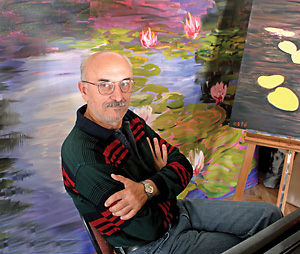 He was born in 1950 in Vršac. He studied in Rijeka and went to college in London. He has been engaged in painting since 1966, first as icon painter. Since 1973, he occasionally painted in London, where he lived until 1979. One of the forms of his presence in the art scene is also organizing exhibitions, and during the previous decade he gathered and presented a group of about a dozen Belgrade painters at www.artmart.tk. In the past, he mostly used drawing and acrylic as art techniques, and during the last years he has been painting oils on canvas. His works in oil are in galleries and private collections in Great Britain and North America. He finds Impressionism close to him as a style and way of expression. He was born in 1950 in Vršac. He studied in Rijeka and went to college in London. He has been engaged in painting since 1966, first as icon painter. Since 1973, he occasionally painted in London, where he lived until 1979. One of the forms of his presence in the art scene is also organizing exhibitions, and during the previous decade he gathered and presented a group of about a dozen Belgrade painters at www.artmart.tk. In the past, he mostly used drawing and acrylic as art techniques, and during the last years he has been painting oils on canvas. His works in oil are in galleries and private collections in Great Britain and North America. He finds Impressionism close to him as a style and way of expression.
TO THE LIMITS AND BEYOND
Among all the great French painters of the XIX century, only Claude Monet, keeping up with the events in art until 1926, experienced the upswing of historical avant-gardes of the XX century. Modern art of that time disappointed him, perhaps because he surpassed it. In his later period, he was close to abstract art, and was also discovered by New York abstract expressionists. He created one of the most beautiful private gardens in history, where water lilies, glicinias and the richness of plants reflected in the water of a small lake, and reflections of light revealed to him what none of the old painters had seen. With the music and harmony of colors of the magical garden, Monet opened the gates of a world free from banal reality. He began painting reduced paintings, almost abstract, reaching purity and cosmism which one could not have gone beyond without endangering art.
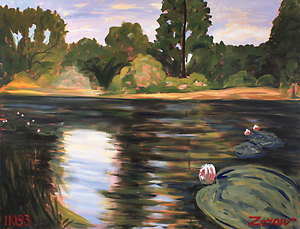 Knowing these challenges, Zoran Danilov attempted to renew not only the world of late Monet in a time burdened with problems, but also the joy of creation derived from nature. In his paintings, the forgotten virginity of water, water lilies and flowers are surprising, as well as improvisation, variation, working in series. His works are homage to the great impressionist, a kind of a nocturne for Monet. Moreover, this Belgrade painter attempted to resolve some of the most difficult painting problems, which are also unyielding expressions of poetics. The night, cold light, water evaporations, are phenomena which lead Zoran Danilov from Monet towards abandoning realistic painting, perhaps even reality. By perceiving the states of nature as spiritual, not abstract, he expresses projections, ideals, a natural utopia, fluidly painted, more than simply taking over from nature or Monet. Therefore we do not evaluate his paintings only by their professional value, the painting skill, but by what they come from and where they are heading to. Knowing these challenges, Zoran Danilov attempted to renew not only the world of late Monet in a time burdened with problems, but also the joy of creation derived from nature. In his paintings, the forgotten virginity of water, water lilies and flowers are surprising, as well as improvisation, variation, working in series. His works are homage to the great impressionist, a kind of a nocturne for Monet. Moreover, this Belgrade painter attempted to resolve some of the most difficult painting problems, which are also unyielding expressions of poetics. The night, cold light, water evaporations, are phenomena which lead Zoran Danilov from Monet towards abandoning realistic painting, perhaps even reality. By perceiving the states of nature as spiritual, not abstract, he expresses projections, ideals, a natural utopia, fluidly painted, more than simply taking over from nature or Monet. Therefore we do not evaluate his paintings only by their professional value, the painting skill, but by what they come from and where they are heading to.
FORMS OF MODERN TRADITIONALISM
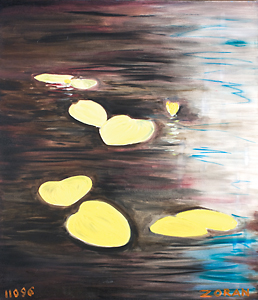 Together with the revolutionary engagement of (post)modern art, some completely different tendencies also appear in it, occasional pauses, resting from experimenting. Its complete history is marked by retro aesthetics, although it is not the main feature of avant-garde. (Post)modern art is often considered a form of modern traditionalism or tradition of modernism, also implied by its history. Together with the revolutionary engagement of (post)modern art, some completely different tendencies also appear in it, occasional pauses, resting from experimenting. Its complete history is marked by retro aesthetics, although it is not the main feature of avant-garde. (Post)modern art is often considered a form of modern traditionalism or tradition of modernism, also implied by its history.
Already the first painters of modernism, such as Van Gogh or Cézanne, wished to paint in the manner of academic realists; the surrealists returned meticulous painting in the spirit of old masters, and Picasso looked up to the ancient Greeks and Velasquez. Between the two world wars, there was a great renewal of Metaphysical Realism (”New Objectivity” movement in Germany, ”Zograph” in Serbia, painters of the Middle West and Mexican mural painters in both Americas), a new form or Realism was born in Italy, France and Belgium, Salvador Dali anticipated Hyperrealism…
After World War II, especially freq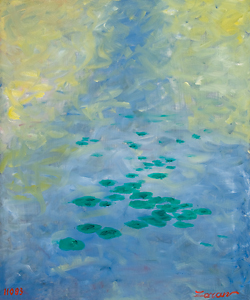 uent in modern art were turns toward taboos. In the time of Conceptualism, Minimalism, Lend Art, kinetic and computer art, hippie rebels discovered the magic of Symbolism, Secession and Fantastic Art, whereas pop artists completely rejected the New York school of abstraction. Figuration was rediscovered, as well as Hyperrealism in the following generation and different forms of renewal of easel painting (such as Neo-Romanticism still present in our art). Especially shocking for conceptualists was the return to painting, especially to the museum type painting. Although Joseph Boyce predicted that artists will never again take a brush in their hands, someone dared to paint in the manner of old masters, in a mannerist, completely museum-like spirit (Italian memory painting, retro avant-garde of the anachronists). uent in modern art were turns toward taboos. In the time of Conceptualism, Minimalism, Lend Art, kinetic and computer art, hippie rebels discovered the magic of Symbolism, Secession and Fantastic Art, whereas pop artists completely rejected the New York school of abstraction. Figuration was rediscovered, as well as Hyperrealism in the following generation and different forms of renewal of easel painting (such as Neo-Romanticism still present in our art). Especially shocking for conceptualists was the return to painting, especially to the museum type painting. Although Joseph Boyce predicted that artists will never again take a brush in their hands, someone dared to paint in the manner of old masters, in a mannerist, completely museum-like spirit (Italian memory painting, retro avant-garde of the anachronists).
The painting of Zoran Danilov Poporić thereby fits the wider renewal of the easel-type form of creation tradition, the so-called return to painting. Unlike others, he has not reached for different forms of 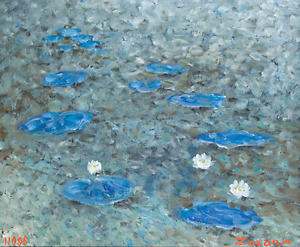 Realism of Fantastic Art, for the metaphysical or cosmic, but turned to Impressionism so despised in late Modern art. His traditionalism is even more unique due to the fact that he discovered the sweetness of XIX century life in the era of dominion of technology, the styles of hedonistic will, the aesthetics of the beautiful and charming. Standing on the side of French culture, Impressionism, already implies something refined, cultivated and regressive. As we have seen and as we will probably see, behind many dangerous turns and abysses of new art, suddenly the attention in the art scene is turned to typically traditional historical styles, forms, poetics and personalities. Realism of Fantastic Art, for the metaphysical or cosmic, but turned to Impressionism so despised in late Modern art. His traditionalism is even more unique due to the fact that he discovered the sweetness of XIX century life in the era of dominion of technology, the styles of hedonistic will, the aesthetics of the beautiful and charming. Standing on the side of French culture, Impressionism, already implies something refined, cultivated and regressive. As we have seen and as we will probably see, behind many dangerous turns and abysses of new art, suddenly the attention in the art scene is turned to typically traditional historical styles, forms, poetics and personalities.
|
